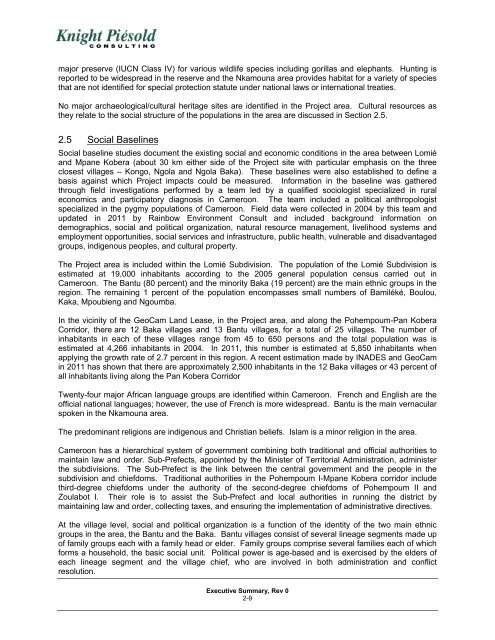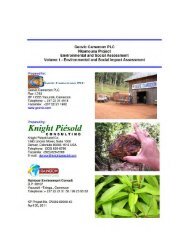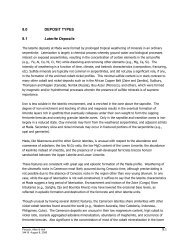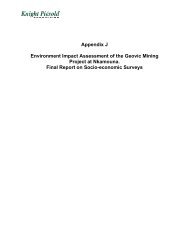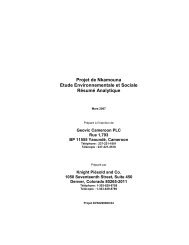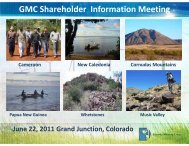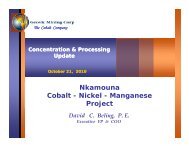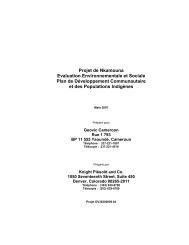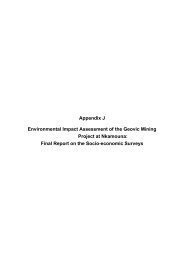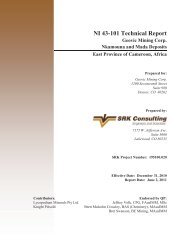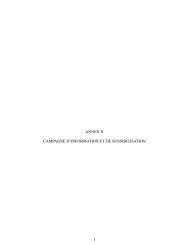Nkamouna Project Environmental & Social Assessment Executive ...
Nkamouna Project Environmental & Social Assessment Executive ...
Nkamouna Project Environmental & Social Assessment Executive ...
Create successful ePaper yourself
Turn your PDF publications into a flip-book with our unique Google optimized e-Paper software.
major preserve (IUCN Class IV) for various wildlife species including gorillas and elephants. Hunting isreported to be widespread in the reserve and the <strong>Nkamouna</strong> area provides habitat for a variety of speciesthat are not identified for special protection statute under national laws or international treaties.No major archaeological/cultural heritage sites are identified in the <strong>Project</strong> area. Cultural resources asthey relate to the social structure of the populations in the area are discussed in Section 2.5.2.5 <strong>Social</strong> Baselines<strong>Social</strong> baseline studies document the existing social and economic conditions in the area between Lomiéand Mpane Kobera (about 30 km either side of the <strong>Project</strong> site with particular emphasis on the threeclosest villages – Kongo, Ngola and Ngola Baka). These baselines were also established to define abasis against which <strong>Project</strong> impacts could be measured. Information in the baseline was gatheredthrough field investigations performed by a team led by a qualified sociologist specialized in ruraleconomics and participatory diagnosis in Cameroon. The team included a political anthropologistspecialized in the pygmy populations of Cameroon. Field data were collected in 2004 by this team andupdated in 2011 by Rainbow Environment Consult and included background information ondemographics, social and political organization, natural resource management, livelihood systems andemployment opportunities, social services and infrastructure, public health, vulnerable and disadvantagedgroups, indigenous peoples, and cultural property.The <strong>Project</strong> area is included within the Lomié Subdivision. The population of the Lomié Subdivision isestimated at 19,000 inhabitants according to the 2005 general population census carried out inCameroon. The Bantu (80 percent) and the minority Baka (19 percent) are the main ethnic groups in theregion. The remaining 1 percent of the population encompasses small numbers of Bamiléké, Boulou,Kaka, Mpoubieng and Ngoumba.In the vicinity of the GeoCam Land Lease, in the <strong>Project</strong> area, and along the Pohempoum-Pan KoberaCorridor, there are 12 Baka villages and 13 Bantu villages, for a total of 25 villages. The number ofinhabitants in each of these villages range from 45 to 650 persons and the total population was isestimated at 4,266 inhabitants in 2004. In 2011, this number is estimated at 5,850 inhabitants whenapplying the growth rate of 2.7 percent in this region. A recent estimation made by INADES and GeoCamin 2011 has shown that there are approximately 2,500 inhabitants in the 12 Baka villages or 43 percent ofall inhabitants living along the Pan Kobera CorridorTwenty-four major African language groups are identified within Cameroon. French and English are theofficial national languages; however, the use of French is more widespread. Bantu is the main vernacularspoken in the <strong>Nkamouna</strong> area.The predominant religions are indigenous and Christian beliefs. Islam is a minor religion in the area.Cameroon has a hierarchical system of government combining both traditional and official authorities tomaintain law and order. Sub-Prefects, appointed by the Minister of Territorial Administration, administerthe subdivisions. The Sub-Prefect is the link between the central government and the people in thesubdivision and chiefdoms. Traditional authorities in the Pohempoum I-Mpane Kobera corridor includethird-degree chiefdoms under the authority of the second-degree chiefdoms of Pohempoum II andZoulabot I. Their role is to assist the Sub-Prefect and local authorities in running the district bymaintaining law and order, collecting taxes, and ensuring the implementation of administrative directives.At the village level, social and political organization is a function of the identity of the two main ethnicgroups in the area, the Bantu and the Baka. Bantu villages consist of several lineage segments made upof family groups each with a family head or elder. Family groups comprise several families each of whichforms a household, the basic social unit. Political power is age-based and is exercised by the elders ofeach lineage segment and the village chief, who are involved in both administration and conflictresolution.<strong>Executive</strong> Summary, Rev 02-9


